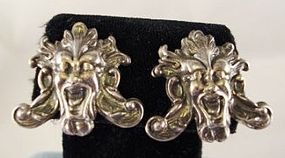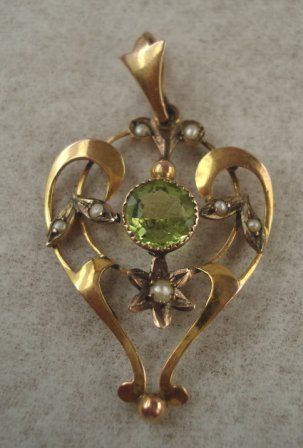 Garnet/glass doublets were a common substitution in the Victorian age when amethyst was one of the most valuable gemstones. A garnet/glass doublet is an assembled stone consisting of a thin crown of garnet, usually almandine, fused or glued to a colored glass pavilion. They were developed to imitate amethyst, peridot, tourmaline, and other transparent gems popular in the last half of the 19th century. Amethyst in particular was scarce and expensive. Russia was the major source of amethyst until it was discovered in Brazil in the nineteenth century, causing the price to drop. These imitation stones were developed before 1840, and manufacture continued until after World War I.
Garnet/glass doublets were a common substitution in the Victorian age when amethyst was one of the most valuable gemstones. A garnet/glass doublet is an assembled stone consisting of a thin crown of garnet, usually almandine, fused or glued to a colored glass pavilion. They were developed to imitate amethyst, peridot, tourmaline, and other transparent gems popular in the last half of the 19th century. Amethyst in particular was scarce and expensive. Russia was the major source of amethyst until it was discovered in Brazil in the nineteenth century, causing the price to drop. These imitation stones were developed before 1840, and manufacture continued until after World War I.
Why garnet? Garnet fuses easily to glass and is harder than glass, so the garnet cap protects the top of the 'stone' from scratches. And, even though the garnet is red, the cap is so thin that doublets can be made in any color, even colorless. Looking at the stone from the top, the color is determined by the color of the glass.
The easiest way to identify a doublet is with a magnifier. Tilt the stone back and forth and look for the difference in luster of garnet and glass. The join between garnet and glass is often not at a regular distance from the girdle of the stone.
The following description of doublet manufacture in the Jura Mountains just after World War I is from Webster [1994]:
After the day's work and our evening meal, a small pile of doublet moulds were put on the kitchen table, together with a packet or two of thin slices of garnet, and also a mound of glass squares. Everyone sat down to their respective job, even neighbours who called in to pass the time with us. Some put in the garnet, others would place a piece of glass on top. The moulds were made of baked clay, measuring about 16 in by 10 in with a number of indentations depending upon the size of doublet required. Actually it was a very pleasant way of passing an evening, refreshments were ad lib and the conversation always interesting and amusing. Friday was an important day, the kiln was stacked with prepared moulds, the fire lit and heated to the correct temperature. Next morning the moulds having cooled were removed. The rough doublets were then sorted into their different colours and sizes ready to be given to the local craftsmen who cut them in their homes. [Webster, R, Gems: their sources, descriptions and identification, Butterworth-Heinemann, Fifth edition 1994 pp458-460]
Friday was an important day, the kiln was stacked with prepared moulds, the fire lit and heated to the correct temperature. Next morning the moulds having cooled were removed. The rough doublets were then sorted into their different colours and sizes ready to be given to the local craftsmen who cut them in their homes. [Webster, R, Gems: their sources, descriptions and identification, Butterworth-Heinemann, Fifth edition 1994 pp458-460]


 The Green Man is an ancient symbol of nature, rebirth, spring...there are many interpretations. He is almost always represented by a man's face surrounded by or even made of leaves. He is found in many places and many cultures and many variations, and may predate Christianity. The symbol is often used as an architectural ornamentation for secular and religious buildings. The motif has never really gone out of style but had a resurgence of popularity in 19th centuryEngland and in this country in the sixties and seventies.The Green Man has been known by many names over the centuries; Green Man is a modern term, dating from 1939.
The Green Man is an ancient symbol of nature, rebirth, spring...there are many interpretations. He is almost always represented by a man's face surrounded by or even made of leaves. He is found in many places and many cultures and many variations, and may predate Christianity. The symbol is often used as an architectural ornamentation for secular and religious buildings. The motif has never really gone out of style but had a resurgence of popularity in 19th centuryEngland and in this country in the sixties and seventies.The Green Man has been known by many names over the centuries; Green Man is a modern term, dating from 1939. Garnet/Glass Doublets
Garnet/Glass Doublets
 Garnet/glass doublets were a common substitution in the Victorian age when amethyst was one of the most
Garnet/glass doublets were a common substitution in the Victorian age when amethyst was one of the most 